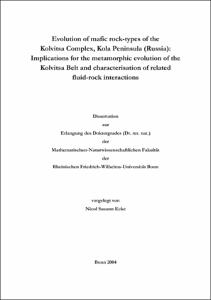Evolution of mafic rock-types of the Kolvitsa Complex, Kola Peninsula (Russia)Implications for the metamorphic evolution of the Kolvitsa Belt and characterisation of related fluid-rock interactions

Evolution of mafic rock-types of the Kolvitsa Complex, Kola Peninsula (Russia)
Implications for the metamorphic evolution of the Kolvitsa Belt and characterisation of related fluid-rock interactions

| dc.contributor.advisor | Raith, Michael M. | |
| dc.contributor.author | Ecke, Nicol Susann | |
| dc.date.accessioned | 2020-04-06T23:46:00Z | |
| dc.date.available | 2020-04-06T23:46:00Z | |
| dc.date.issued | 2005 | |
| dc.identifier.uri | https://hdl.handle.net/20.500.11811/2137 | |
| dc.description.abstract | Within the Lapland-Kola Orogen, situated in the north-eastern Baltic Shield, the Kolvitsa-Umba Belt forms part of a major suture zone. Remnants of this important Svecofennian collision zone separating the Late Archaean Belomorian terrane from crustal plates of the Central Kola terrane are exposed along the north-eastern coast of the White Sea. The first part of this study details the mineral chemistry, petrology and textural relationships of mafic granulites and zones of amphibolitisation from the magmatic Kolvitsa Complex in order to provide an insight into their metamorphic evolution. At the south-eastern boundary of the Kolvitsa Complex, P-T estimates of the high-grade granulite-facies shear deformation c. 1.91 Ga ago, yielded 900 to 1050 oC, at pressures of 12 to 15 kbar. In the central part of the Kolvitsa Massif temperatures did not exceed 800 oC, while prevailing pressures were rather high (10 to 12.5 kbar). The retrograde P-T trajectory documents tectonic exhumation and was deduced from decompressional reaction textures in sheared metagabbros and from mineral assemblages in zones of amphibolitisation. The latter characterise the temperature conditions that prevailed during fluid infiltration and retrogression (680-750oC) c. 1896 to 1898 Ma ago (U-Pb titanite ages). Deduced integrated cooling and exhumation rates vary from 10 to 20 oC/Ma and from 0.7 to 2 mm/a, respectively and are consistent with what is known from modern orogenic belts. The second part of the thesis focuses on the systematics of fluid-rock interaction and the mechanisms of fluid flow systems at middle to deep crustal levels. Retrograde zones of amphibolitisation are direct evidence of fluid infiltration and provide important clues to the understanding of processes in deep-crustal metamorphic flow systems, such as textural re-equilibration, re-crystallisation, element and mass transfer and help to identify the driving forces of fluid flux. Infiltration of hydrous fluids caused dramatic changes in mineralogy of the mafic host granulites and led to nearly monomineralic Hbl ±Pl, Ttn felses. Beside hydration and retrogression, fluid infiltration was accompanied by mineralogically controlled element transfer. Metasomatic zones are characterised by a loss of SiO2, whereas MgO, FeO, CaO and TiO2 contents increase. Element transfer is interpreted as resulting from up-temperature fluid flow of an externally derived, low δ18O fluid (7 - 8.5 ‰) which was enriched in silica and 40Ar. Volumetric fluid-rock ratios and minimum time-integrated fluid fluxes were estimated on the basis of Si solubility in water and range from 50:1 to 150:1 and from 106 to 107 cm3/cm2. High fluid-rock ratios and fluid fluxes are in agreement with those of shear zones characterised by significant element transfer (e.g. Dipple & Ferry, 1992; Streit & Cox, 1998; Cartwright & Barnicoat, 2003; Yonkee et al., 2003; Barnes et al., 2004). Sm-Nd whole rock isotope data show negative isotopic shifts in zones of amphibolitisation and are further evidence for the mobility of REE via an infiltrating fluid. Fluids derived from the overthrust Archaean Belomorian basement gneisses would account for the lower Sm/Nd ratios in the zones of amphibolitisation | |
| dc.language.iso | eng | |
| dc.rights | In Copyright | |
| dc.rights.uri | http://rightsstatements.org/vocab/InC/1.0/ | |
| dc.subject | Kola Peninsula | |
| dc.subject | Kolvitsa-Umba Belt | |
| dc.subject | mafic granulites | |
| dc.subject | pressure-temperature estimates | |
| dc.subject | fluid-rock interaction | |
| dc.subject | fluid flow | |
| dc.subject | element transfer | |
| dc.subject | Palaeoproterozoic | |
| dc.subject.ddc | 550 Geowissenschaften | |
| dc.title | Evolution of mafic rock-types of the Kolvitsa Complex, Kola Peninsula (Russia) | |
| dc.title.alternative | Implications for the metamorphic evolution of the Kolvitsa Belt and characterisation of related fluid-rock interactions | |
| dc.type | Dissertation oder Habilitation | |
| dc.publisher.name | Universitäts- und Landesbibliothek Bonn | |
| dc.publisher.location | Bonn | |
| dc.rights.accessRights | openAccess | |
| dc.identifier.urn | https://nbn-resolving.org/urn:nbn:de:hbz:5N-04999 | |
| ulbbn.pubtype | Erstveröffentlichung | |
| ulbbnediss.affiliation.name | Rheinische Friedrich-Wilhelms-Universität Bonn | |
| ulbbnediss.affiliation.location | Bonn | |
| ulbbnediss.thesis.level | Dissertation | |
| ulbbnediss.dissID | 499 | |
| ulbbnediss.date.accepted | 10.12.2004 | |
| ulbbnediss.fakultaet | Mathematisch-Naturwissenschaftliche Fakultät | |
| dc.contributor.coReferee | Braun, Ingo |
Dateien zu dieser Ressource
Das Dokument erscheint in:
-
E-Dissertationen (4115)




